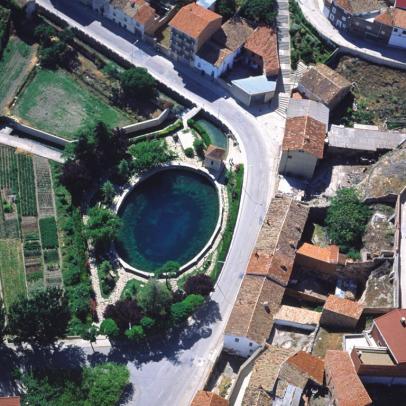The fountain of Cella is a large artesian well that has been working since the 12th century. This well is particularly relevant because it is one of the largest artesian wells in Europe. As a matter of fact, it carries water to three irrigation canals which reach seven towns.
This artesian well underwent alterations in the 18th century. It has an elliptical shape and it is almost 35 metres in diameter. Its perimeter is 130 metres and it is surrounded by a dressed stone parapet. Water flows out from one of the sides, which is covered by a chapel built in the honour of San Clemente. The depth of the well is 9 metres at the edge and 11.5 metres in the centre. The well has a flow rate of 3,500 litres per second.
As a result of the use of this well as a source of water, the Roman aqueduct that was used for centuries to carry water from Albarracín to Cella disappeared. In spite of the fact that the well was dug up in the 12th century, Cella is still referred to in El Cantar de Mío Cid as the village of the canal, which is a clear reference to the aqueduct.
At the time of El Cid, Cella was a frontier region and, in consequence, an area prone to the practice of raiding and looting by troops and mercenaries. This is the reason why the lines of El Cantar de Mío Cid place special emphasis to this village: three years after having been exiled, El Cid camped in Cella. He sent messengers to Aragón, Navarra and Castile and waited for three days to reunite the men that would accompany him to conquest Valencia.
Although the exact place where El Cid encamped remains unclear, we have decided to mark the site on the outskirts of the castle, next to the fountain and the orchards of Cella. This was undoubtedly a great place to eat and rest.
Rev. PAB: 28.12.18






